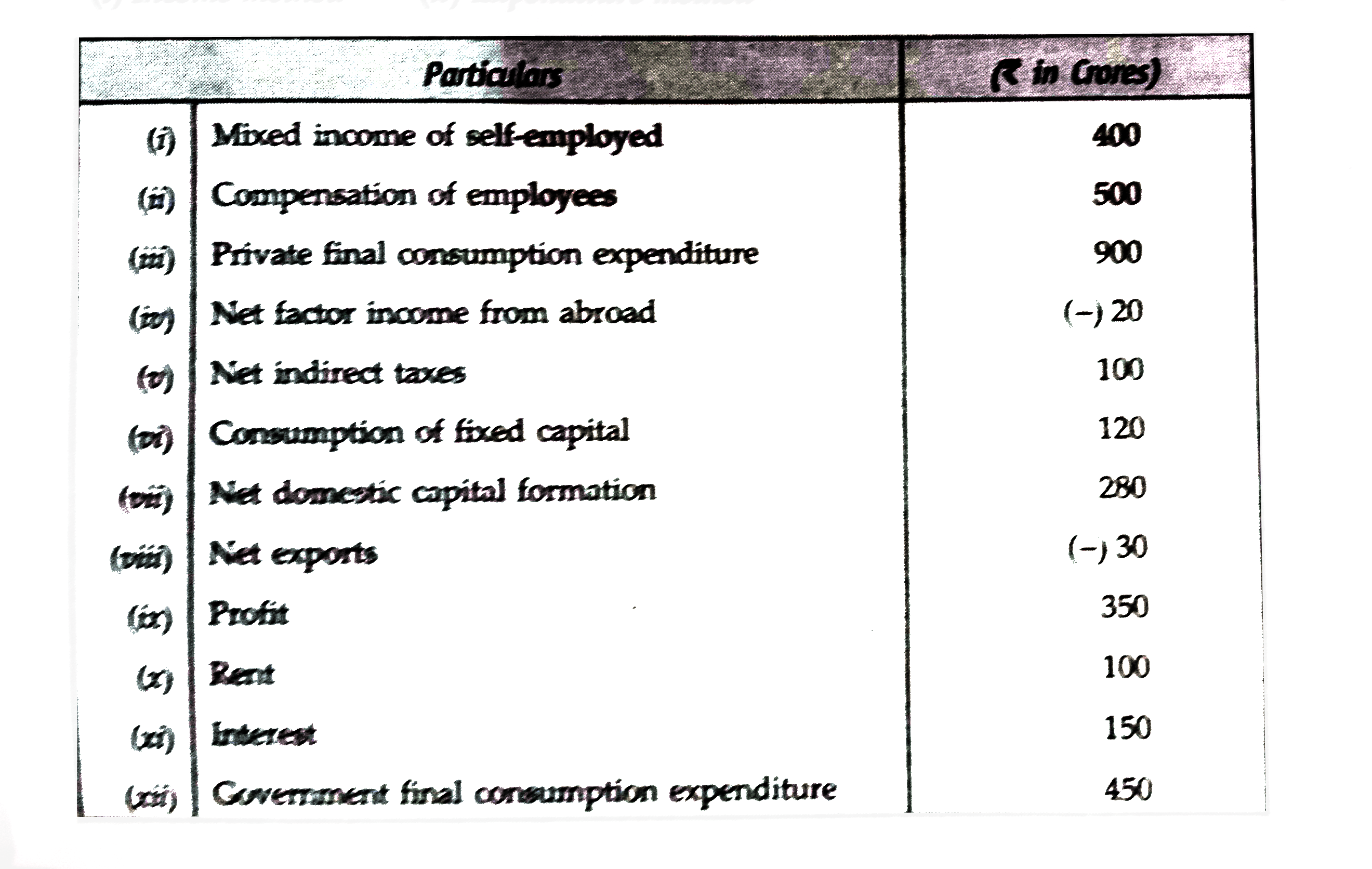Explain the following
(i) Why are exports added while calculating GDP through the expenditure approach ?
(ii) Why are subsidies added while calculating national income ?
(iii) Why are intermediate cost deducted for arriving at GDP through the production approach ?
(i) Exports are added because these are produced within the economic (domestic) territory of the country. GDP is also defined in the same Way.
(ii) Subsidies are added because these are paid by government to production unit over and above the price paid by the buyers. As such these add to the factor payments paid by the production units.
(iii) Intermediate cost is deducted to avoid double counting of the value of the same product more than once. By doing so we arrived at the value of final products which counts value of a product only once
Topper's Solved these Questions
- BALANCE OF PAYMENTSBOOK - SK AGGARWALACHAPTER - BALANCE OF PAYMENTSEXERCISE - Section A : Sample question paper -1
3 Videos
- BALANCE OF PAYMENTSBOOK - SK AGGARWALACHAPTER - BALANCE OF PAYMENTSEXERCISE - Section A : Sample question paper -2
2 Videos
- BALANCE OF PAYMENTSBOOK - SK AGGARWALACHAPTER - BALANCE OF PAYMENTSEXERCISE - CBSE Examination questions
15 Videos
- AGRICULTURE :1950-1990BOOK - SK AGGARWALACHAPTER - AGRICULTURE :1950-1990EXERCISE - Multiple Choice Questions
5 Videos
- DETERMINATION OF INCOME AND EMPLOYMENTBOOK - SK AGGARWALACHAPTER - DETERMINATION OF INCOME AND EMPLOYMENTEXERCISE - CBSE Examination Questions
2 Videos
Similar Questions
Explain the following
(i) Why are imports deducted while calculating domestic product through the expenditure method ?
(ii) Why is 'indirect tax' deducted while estimating national income by expenditure method ?
(iii) Why are free facilities given the employees included in national income ?
View SolutionFrom the following data, find out :
(i) Value of gross product of the firm
(ii) Net value added at market price
(iii) Net value added at factor cost
(iv) Also, prove that : National income (By income method)

View SolutionWhate happens in the following activities and why?
(i) An electrolyte is added to a hydrated ferric oxide sol in water.
(ii) A bean of light is passed through a colloidal solution.
(iii) An electric current is passed through a colloidal soluidal solution.
View SolutionWhate happens in the following activities and why?
(i) An electrolyte is added to a hydrated ferric oxide sol in water.
(ii) A bean of light is passed through a colloidal solution.
(iii) An electric current is passed through a colloidal soluidal solution.
View SolutionGive reasons for the following :
(i) Metals can be recovered from their ores by chemical methods.
(ii) High purity metals can be obtained by zone refining method.
(iii) Why is sodium choride added during electrolysis of fused anhydrous magnesium chloride ?
(iv) Why is chalcocite roasted and not calcinated during recovery of copper ?
View Solution(i) A ray of white light breaks up into its components while passing through a glass prism. Draw a ray diagram to show the path of rays.
(ii) Mark the least deviated colour in your diagram.
(iii) Why do different coloured rays deviate differently in a prism ?
View SolutionCalculate NPmp from the following data:
(i) Household final consumption expenditure 1000
(ii) Net domestic fixed capital formation 100
(iii) Government final consumption expenditure 200
(iv) Final consumption expenditure of private non-profit institutions serving households 50
(v) Net change in stocks 40
(vi) Net exports (-)20
(vii) Net factor income from abroad 10
(viii) Indirect tax 70
(ix) 20
View SolutionWhen a galvanometer of resistance G is shunted with a low resistance S, then the effective resistance Reff of galvanometer becomes
Reff=GSG+S
If current is passed through such a galvanometer, then the major amount of current flows through shunt and the rest through galvanometer, i.e., the current divides itself in the inverse ratio of resistance.
Read the above passage and answer the following questions:
(i) Why is the resistance of shunted galvanometer lower than that of shunt?
(ii) A galvanometer of resistance 30Ω is shunted by a resistance of 3Ω. What fraction of the main current passes (i) through the galvanometer and (ii) through the shunt?
(iii) What are the basic values you learn from the above study?
View SolutionFrom the following data, calculate Gross National Product at Market Price by
(i) Income method (ii) Expenditure method

View Solution(i) Calculate the current through a lamp of 25 W operating at 250 V.
(ii) Why elements of electrical heating devices are made up of alloys?
View Solution
